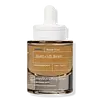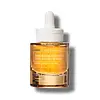What's inside
What's inside
 Key Ingredients
Key Ingredients

 Benefits
Benefits

 Concerns
Concerns

 Ingredients Side-by-side
Ingredients Side-by-side

Water
Skin ConditioningPentylene Glycol
Skin ConditioningSinorhizobium Meliloti Ferment Filtrate
Skin ConditioningSaccharomyces/Xylinum/Black Tea Ferment
Skin ConditioningGlycerin
HumectantAscorbyl Palmitate
AntioxidantAvena Sativa Kernel Extract
AbrasiveBenzyl Alcohol
PerfumingBrassica Napus Extract
Skin ConditioningButylene Glycol
HumectantCetyl Hydroxyethylcellulose
Emulsion StabilisingEpigallocatechin Gallate
AntioxidantEpigallocatechin Gallatyl Glucoside
AntioxidantEthylhexylglycerin
Skin ConditioningGlyceryl Acrylate/Acrylic Acid Copolymer
HumectantHelianthus Annuus Seed Oil
EmollientHexapeptide-11
Skin ConditioningHydrolyzed Sodium Hyaluronate
Skin ConditioningHydrolyzed Soybean Fiber
Skin ProtectingHydroxyethylcellulose
Emulsion StabilisingLactic Acid
BufferingLecithin
EmollientParfum
MaskingPeucedanum Graveolens Extract
TonicPhenoxyethanol
PreservativePinus Nigra Bud/Needle Extract
AntimicrobialPolyacrylate Crosspolymer-6
Emulsion StabilisingPolyglyceryl-5 Laurate
EmulsifyingPotassium Sorbate
PreservativeSodium Benzoate
MaskingSodium Carboxymethyl Beta-Glucan
CleansingSodium Dehydroacetate
PreservativeSodium Hyaluronate
HumectantTetrasodium Glutamate Diacetate
Tocopherol
AntioxidantXanthan Gum
EmulsifyingWater, Pentylene Glycol, Sinorhizobium Meliloti Ferment Filtrate, Saccharomyces/Xylinum/Black Tea Ferment, Glycerin, Ascorbyl Palmitate, Avena Sativa Kernel Extract, Benzyl Alcohol, Brassica Napus Extract, Butylene Glycol, Cetyl Hydroxyethylcellulose, Epigallocatechin Gallate, Epigallocatechin Gallatyl Glucoside, Ethylhexylglycerin, Glyceryl Acrylate/Acrylic Acid Copolymer, Helianthus Annuus Seed Oil, Hexapeptide-11, Hydrolyzed Sodium Hyaluronate, Hydrolyzed Soybean Fiber, Hydroxyethylcellulose, Lactic Acid, Lecithin, Parfum, Peucedanum Graveolens Extract, Phenoxyethanol, Pinus Nigra Bud/Needle Extract, Polyacrylate Crosspolymer-6, Polyglyceryl-5 Laurate, Potassium Sorbate, Sodium Benzoate, Sodium Carboxymethyl Beta-Glucan, Sodium Dehydroacetate, Sodium Hyaluronate, Tetrasodium Glutamate Diacetate, Tocopherol, Xanthan Gum
Water
Skin ConditioningGlycerin
HumectantPropanediol
SolventSodium Polyacryloyldimethyl Taurate
Emulsion Stabilising1,2-Hexanediol
Skin ConditioningAcetyl Hexapeptide-8
HumectantAlanine
MaskingArginine
MaskingAvena Strigosa Seed Extract
Skin ConditioningBetaine
HumectantCaprylyl Glycol
EmollientCellulase
Citric Acid
BufferingDictyopteris Polypodioides Extract
EmollientDisodium Phosphate
BufferingEpigallocatechin Gallatyl Glucoside
AntioxidantEthylhexylglycerin
Skin ConditioningGallyl Glucoside
AntioxidantGlutamic Acid
HumectantGlycine
BufferingHydrolyzed Sodium Hyaluronate
Skin ConditioningHydrolyzed Soy Flour
Skin ConditioningHydroxyacetophenone
AntioxidantLactic Acid
BufferingLecithin
EmollientLinolenic Acid
CleansingLysine Hcl
Skin ConditioningPancratium Maritimum Extract
BleachingPCA
HumectantPentylene Glycol
Skin ConditioningPinus Nigra Bud/Needle Extract
AntimicrobialProline
Skin ConditioningPropyl Gallate
AntioxidantSerine
MaskingSodium Acetylated Hyaluronate
HumectantSodium Carboxymethyl Beta-Glucan
CleansingSodium Hyaluronate
HumectantSodium Hyaluronate Crosspolymer
HumectantSodium Lactate
BufferingSodium PCA
HumectantSodium Phosphate
BufferingTetrasodium Glutamate Diacetate
Threonine
Benzyl Alcohol
PerfumingDehydroacetic Acid
PreservativePotassium Sorbate
PreservativeSodium Benzoate
MaskingWater, Glycerin, Propanediol, Sodium Polyacryloyldimethyl Taurate, 1,2-Hexanediol, Acetyl Hexapeptide-8, Alanine, Arginine, Avena Strigosa Seed Extract, Betaine, Caprylyl Glycol, Cellulase, Citric Acid, Dictyopteris Polypodioides Extract, Disodium Phosphate, Epigallocatechin Gallatyl Glucoside, Ethylhexylglycerin, Gallyl Glucoside, Glutamic Acid, Glycine, Hydrolyzed Sodium Hyaluronate, Hydrolyzed Soy Flour, Hydroxyacetophenone, Lactic Acid, Lecithin, Linolenic Acid, Lysine Hcl, Pancratium Maritimum Extract, PCA, Pentylene Glycol, Pinus Nigra Bud/Needle Extract, Proline, Propyl Gallate, Serine, Sodium Acetylated Hyaluronate, Sodium Carboxymethyl Beta-Glucan, Sodium Hyaluronate, Sodium Hyaluronate Crosspolymer, Sodium Lactate, Sodium PCA, Sodium Phosphate, Tetrasodium Glutamate Diacetate, Threonine, Benzyl Alcohol, Dehydroacetic Acid, Potassium Sorbate, Sodium Benzoate
Ingredients Explained
These ingredients are found in both products.
Ingredients higher up in an ingredient list are typically present in a larger amount.
Benzyl Alcohol is most commonly used as a preservative. It also has a subtle, sweet smell. Small amounts of Benzyl Alcohol is not irritating and safe to use in skincare products. Most Benzyl Alcohol is derived from fruits such as apricots.
Benzyl Alcohol has both antibacterial and antioxidant properties. These properties help lengthen the shelf life of products. Benzyl Alcohol is a solvent and helps dissolve other ingredients. It can also improve the texture and spreadability.
Alcohol comes in many different forms. Different types of alcohol will have different effects on skin. This ingredient is an astringent alcohol.
Using high concentrations of these alcohols are drying on the skin. They may strip away your skin's natural oils and even damage your skin barrier. Astringent alcohols may also irritate skin.
Other types of astringent alcohols include:
According to the National Rosacea Society based in the US, you should be mindful of products with these alcohols in the top half of ingredients.
Any type of sanitizing product will have high amounts of alcohol to help kill bacteria and viruses.
Learn more about Benzyl AlcoholThis ingredient is a modified version of the famous antioxidant found in green tea, EGCG.
EGCG has antioxidant and anti-inflammatory properties. It has been shown to protect skin from UV-induced damage.
Since this ingredient is modified to attach to a glucose molecule, it also has great hydrating properties.
Learn more about Epigallocatechin Gallatyl GlucosideEthylhexylglycerin (we can't pronounce this either) is commonly used as a preservative and skin softener. It is derived from glyceryl.
You might see Ethylhexylglycerin often paired with other preservatives such as phenoxyethanol. Ethylhexylglycerin has been found to increase the effectiveness of these other preservatives.
Glycerin is already naturally found in your skin. It helps moisturize and protect your skin.
A study from 2016 found glycerin to be more effective as a humectant than AHAs and hyaluronic acid.
As a humectant, it helps the skin stay hydrated by pulling moisture to your skin. The low molecular weight of glycerin allows it to pull moisture into the deeper layers of your skin.
Hydrated skin improves your skin barrier; Your skin barrier helps protect against irritants and bacteria.
Glycerin has also been found to have antimicrobial and antiviral properties. Due to these properties, glycerin is often used in wound and burn treatments.
In cosmetics, glycerin is usually derived from plants such as soybean or palm. However, it can also be sourced from animals, such as tallow or animal fat.
This ingredient is organic, colorless, odorless, and non-toxic.
Glycerin is the name for this ingredient in American English. British English uses Glycerol/Glycerine.
Learn more about GlycerinThis ingredient is created by putting sodium hyaluronate through hydrolysis.
You might know this as 'mini' or 'ultra low-molecular weight' hyaluronic acid. The small molecule size means it is able to travel deeper in the skin.
According to studies, low molecular-weight hyaluronic acid can:
One study from 2011 found ultra-low weight HA to show pro-inflammatory properties. Another study from 2022 found it to downregulate UV-B induced inflammation.
Hydrolysis is a process of changing a molecule using water or enzymes.
This ingredient is water-soluble.
Learn more about Hydrolyzed Sodium HyaluronateLactic Acid is another well-loved alpha hydroxy acid (AHA). It is gentler than glycolic acid but still highly effective.
Its main role is to exfoliate the surface of the skin by loosening the “glue” that holds dead skin cells together. Shedding those old cells leads to smoother, softer, and more even-toned skin.
Because lactic acid molecules are larger than glycolic acid, they don’t penetrate as deeply. This means they’re less likely to sting or irritate, making it a great choice for beginners or those with sensitive skin.
Like glycolic acid, it can:
Lactic acid also acts as a humectant (like hyaluronic acid). It can draw water into the skin to improve hydration and also plays a role in the skin's natural moisturizing factor (NMF) in the form of sodium lactate.
Studies show it can boost ceramide production to strengthen the skin barrier and even help balance the skin’s microbiome.
To get results, choose products with a pH between 3-4.
Lower strengths (5-12%) focus on surface exfoliation; higher strengths (12% and up) can reach deeper in the dermis (deeper, supportive layer) to improve skin texture and firmness over time.
Though it was originally derived from milk, most modern lactic acid used in skincare is vegan. It is made through non-dairy fermentation to create a bio-identical and stable form suitable for all formulations.
When lactic acid shows up near the end of an ingredient list, it usually means the brand added just a tiny amount to adjust the product’s pH.
Legend has it that Cleopatra used to bathe in sour milk to help reduce wrinkles.
Lactic acid is truly a gentle multitasker: it exfoliates, hydrates, strengthens, and brightens. It's a great ingredient for giving your skin a smooth, glowing, and healthy look without the harshness of stronger acids.
Read more about some other popular AHA's here:
Learn more about Lactic AcidLecithin is a term for a group of substances found in the cell membranes of plants, animals, and humans. They are made up of mixture of phospholipids.
This ingredient has emollient and emulsifying properties.
As an emollient, lecithen helps soften the skin and creates a barrier to keep moisture in.
As an emulsifier, it also helps prevent water and oil ingredients from separating. Lecithin can also help ingredients be better absorbed by the skin.
This is because the phospholipids in lecithin produce liposomes. Liposomes help other ingredients get through the skin barrier.
Depending on the source of this ingredient, lecithin may not be fungal acne safe. This is because some sources of lecithin come from soybean oil, which may feed the malassezia yeast that feeds fungal acne.
We recommend reaching out to the brand you are purchasing from to inquire about the source of their lecithin.
Some other names for this ingredient include soy lecithin and deoiled soy lecithin.
Learn more about LecithinPentylene glycol is typically used within a product to thicken it. It also adds a smooth, soft, and moisturizing feel to the product. It is naturally found in plants such as sugar beets.
The hydrophilic trait of Pentylene Glycol makes it a humectant. As a humectant, Pentylene Glycol helps draw moisture from the air to your skin. This can help keep your skin hydrated.
This property also makes Pentylene Glycol a great texture enhancer. It can also help thicken or stabilize a product.
Pentylene Glycol also acts as a mild preservative and helps to keep a product microbe-free.
Some people may experience mild eye and skin irritation from Pentylene Glycol. We always recommend speaking with a professional about using this ingredient in your routine.
Pentylene Glycol has a low molecular weight and is part of the 1,2-glycol family.
Learn more about Pentylene GlycolPinus Nigra Bud/Needle Extract is an antioxidant.
Potassium Sorbate is a preservative used to prevent yeast and mold in products. It is commonly found in both cosmetic and food products.
This ingredient comes from potassium salt derived from sorbic acid. Sorbic acid is a natural antibiotic and effective against fungus.
Both potassium sorbate and sorbic acid can be found in baked goods, cheeses, dried meats, dried fruit, ice cream, pickles, wine, yogurt, and more.
You'll often find this ingredient used with other preservatives.
Learn more about Potassium SorbateSodium Benzoate is a preservative. It's used in both cosmetic and food products to inhibit the growth of mold and bacteria. It is typically produced synthetically.
Both the US FDA and EU Health Committee have approved the use of sodium benzoate. In the US, levels of 0.1% (of the total product) are allowed.
Sodium benzoate works as a preservative by inhibiting the growth of bacteria inside of cells. It prevents the cell from fermenting a type of sugar using an enzyme called phosphofructokinase.
It is the salt of benzoic acid. Foods containing sodium benzoate include soda, salad dressings, condiments, fruit juices, wines, and snack foods.
Studies for using ascorbic acid and sodium benzoate in cosmetics are lacking, especially in skincare routines with multiple steps.
We always recommend speaking with a professional, such as a dermatologist, if you have any concerns.
Learn more about Sodium BenzoateWe don't have a description for Sodium Carboxymethyl Beta-Glucan yet.
Sodium Hyaluronate is hyaluronic acid's salt form. It is commonly derived from the sodium salt of hyaluronic acid.
Like hyaluronic acid, it is great at holding water and acts as a humectant. This makes it a great skin hydrating ingredient.
Sodium Hyaluronate is naturally occurring in our bodies and is mostly found in eye fluid and joints.
These are some other common types of Hyaluronic Acid:
Learn more about Sodium HyaluronateTetrasodium Glutamate Diacetate is a chelating agent. Chelating agents help prevent metal ions from binding to other ingredients. This helps prevent unwanted effects and reactions from a product. These metal ions may come from water and are found in miniscule amounts.
Tetrasodium Glutamate Diacetate can also help other preservatives be more effective.
Water. It's the most common cosmetic ingredient of all. You'll usually see it at the top of ingredient lists, meaning that it makes up the largest part of the product.
So why is it so popular? Water most often acts as a solvent - this means that it helps dissolve other ingredients into the formulation.
You'll also recognize water as that liquid we all need to stay alive. If you see this, drink a glass of water. Stay hydrated!
Learn more about Water